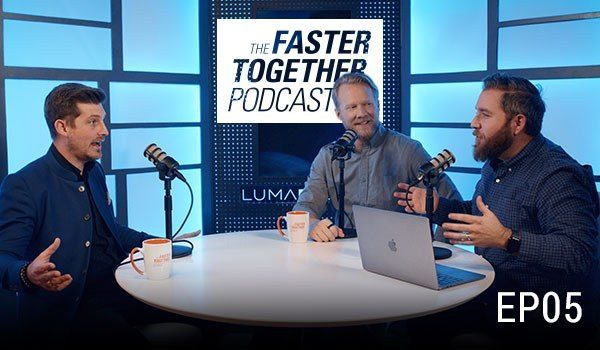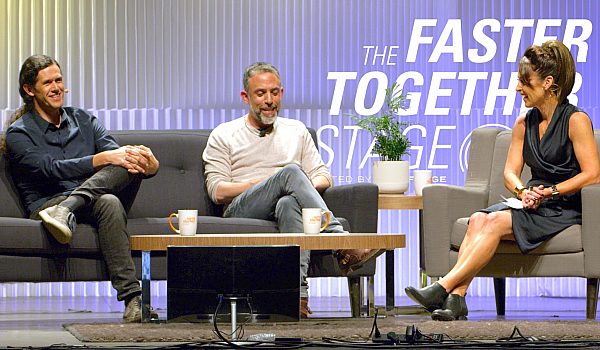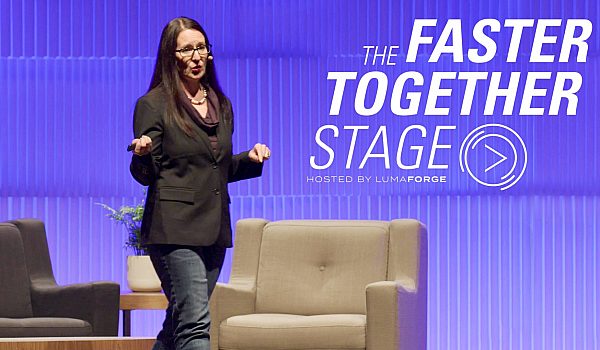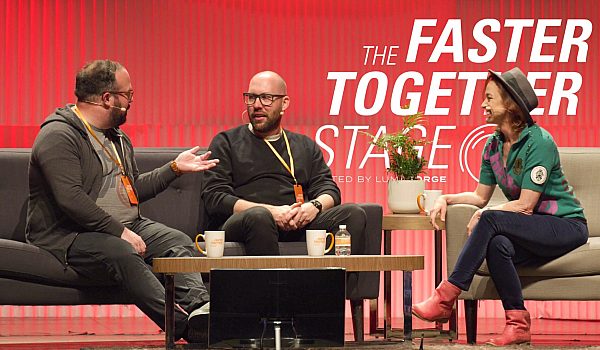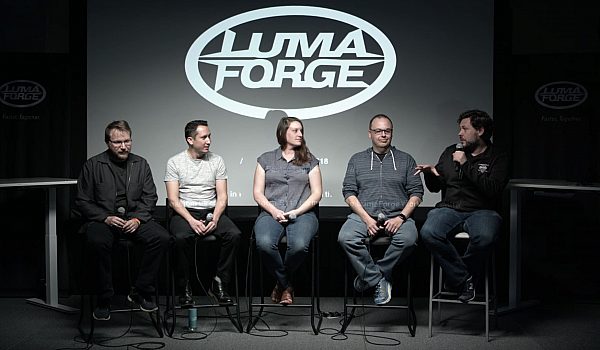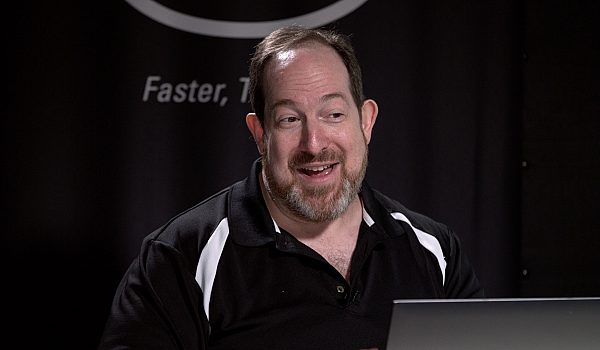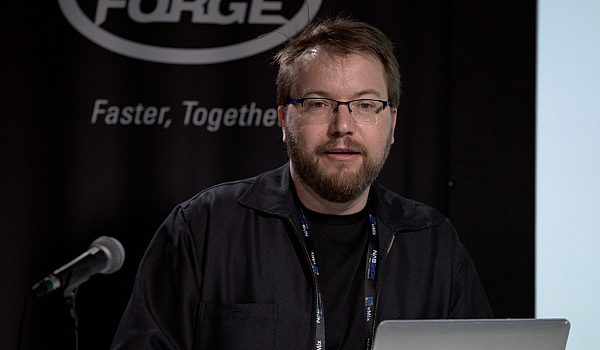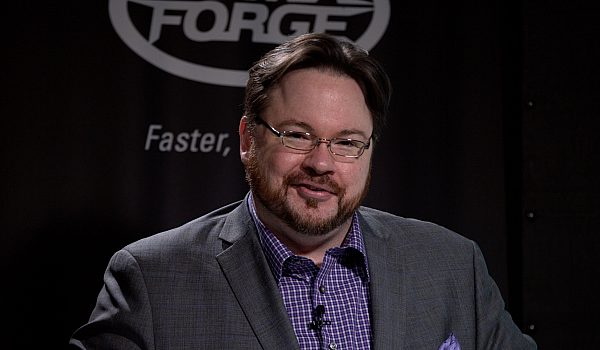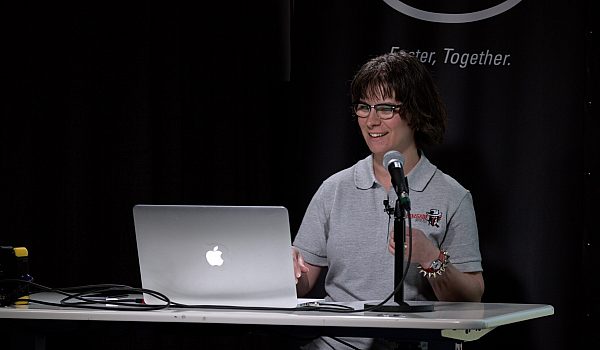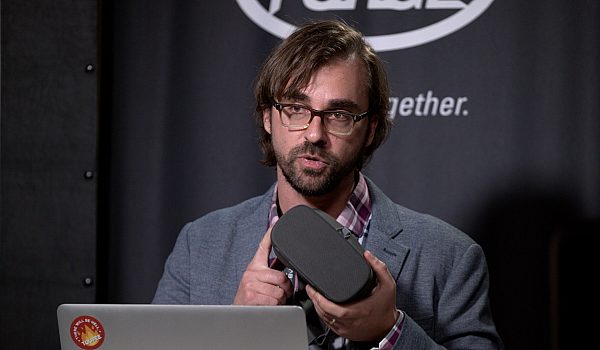ProRes RAW and ProRes RAW HQ were the talk of NAB 2018 in Las Vegas this year. During NAB, Atomos announced their support of ProRes RAW on their SHOGUN INFERNO and SUMO19. In this presentation, Jeromy Young talks about Atomos' collaboration with Apple over the years, including ProRes RAW and the benefits it brings to both production and post production.
ProRes RAW is currently supported on Atomos and DJI capture devices and in Final Cut Pro X 10.4.1. For more information, go to atomos.com/proresraw or apple.com/final-cut-pro/
- We want everyone to know that we've been working very hard for the last year and a half with a little American company called Apple. And this partnership came about in 2011 NAB when we released our first product. This is a picture of Ninja 2, but it looks exactly the same. The original product was only HDMI in. We added playback of it. But what it is, is the first time that I, myself as the founder and CEO of Atomos, teamed up with the ProRes guys. And they invented ProRes in 2007, and that algorithm team is seriously amazing. It's the most efficient CPU encode-decode format for quality and size. And we all now know that everyone really loved it.
It's now 80 percent of recording's done in ProRes, and the production's are done in it, and it's even now a ubiquitous format for delivery. Everyone requests ProRes. So our business has gone extremely well because of it, but this is what we did. I sat in front of Steve Jobs for 20 minutes, and I pitched my Ninja. And what Ninja was was taking computer hard discs... Basically I took a capture card, put it in the camera. Took the HDMI feed in, recorded directly to ProRes from the sensor. So we bypassed MPEG compression. Record, play, monitor, and edit at the camera. And then you take the file, and you do all the really cool stuff in Final Cut, and Final Cut 7 was a boom, and we had a very successful partnership. We have now today sold 250 thousand units of around a thousand dollar product. That's a lot of units. And we continue to do record, play, monitor, and edit. More recently, we've been recording RAW from the sensors of Japanese cameras. I grew up in video in Japan. I lived there 10 years and I speak Japanese, and I'm very close to the development teams making product in the trenches. I used to make DV editing boards with all of these companies so that's my connection to the camera makers.
What Atomos do is we connect the imagine world to the computer world like no one else does. We think about what happens in post production at the same time as what happens on set, and we imply our AtomOS operating system that's really simple to use like an iPhone. That's what we did. It looks like an iPhone. It works like that. It's simple, and it works. So 250 thousand units later, we have been solving the HDR equation by mapping to a 1500 nit screen, the wonderful range of brightness that these sensors are capable of today, so you can see it the way an HDR TV will represent it. So we've been solving half the problem of Log footage which is the brightness squashed into a video image being not exactly easy to use because it's washed out because it's stuck into a Rec. 709 range and there's a lot more brightness so it's squashed in there and it goes all foggy. So we resolved that on our panel.
How do we do that? We take the camera image, we're processing that, we made the LEDs behind the LCD, we control the whole video pipeline to represent it accurately for you. And we were solving half the problem. We're taking RAW from the cameras to be able to do that in a really efficient way, but everything after that was really difficult. CinemaDNG, great format from Adobe for photos, but putting 60 frames a second of 'em together in 4K is a nightmare. It's a photo format. Or you got to ProRes but then you bake in everything. And then I'm making those decisions for you. You probably don't want me to be doing that 'cause I'm not a cinematographer. So what we did was kinda half solved the problem. So went back to our good friends at Apple, and we both has similar ideas on, "What if you could "take the ProRes workflow and do it with RAW?" So a year and a half ago we began co-development because without recording at the camera, there is no RAW format. Enter... ProRes RAW. Now what ProRes RAW does is it takes not the RGB video pixel after it's been processed by the camera which is what is normal video. So the camera would take it's sensel values which are the R, G, B Bayer pattern. Red, blue, two greens. Very awesome guy called Mr. Bayer at Kodak in Rochester made this amazing sensor format that's used by everybody, and so it's very consistent across all cameras. CMOS sensors all deliver that. And so each pixel, RGB pixel, that we know as video starts off its life as four different mini pixels. Doped for red, doped for green, doped for blue. And that works with silicon to give you a voltage, and there's a lot of analog involved.
Basically that's the core of an image. And what ProRes was, was the camera would process it, put those four sensels into a pixel, and it would then go into the wonderful ProRes engine which packed it up really efficiently to keep quality. It was a great size vs. quality comparison. As we know, it's been very successful. But if you go back one step and say, "Let's not let the camera decide "how to make an RGB pixel for me. "Let's capture the original Bayer pattern sensels." And then you go and you put it through the ProRes engine, which is really efficient for CPUs and built for processing in that world, you're bridging the imaging world directly to the computer world so we were extremely interested in helping achieve that. But that's what it is. We take out this step in the middle and we move it over to the computer. Does anyone know an industry that keeps eating functions from other industries? Yeah, it's called the computer industry. And what's just happened with ProRes RAW, and I think everyone will wake up after NAB and realize what has happened, is the computer industry just took a major chunk of imaging. And it's doing it in a very efficient way. It's the flexibility of RAW.
We can move those sensels around, and we can adjust them, we can take 'em up to 16-bit from different cameras. We record 12-bit from all of the Japanese cameras, but that will improve in time. ProRes is capable... ProRes RAW is capable of way more than 16-bit. It's resolution independent. It's frame rate independent. All the things that Apple have been pushing for a long time in the flexibility of the codec comes to fruition. So it's the flexibility of RAW and the performance of ProRes. So we get all the wonderful imaging and all the wonderful processing. Doesn't that sound cool? Anyone who's tried to do video always gets to a point where they're like, "Ah, I can't do what I want so I have to compromise." Well now, we don't have to compromise. It's available today in Final Cut X on iMac Pros.
And I gotta tell you, there is a massive change inside Apple the last few years. I think they've finished building their building, and they're pretty good at making phones now. And they're focused again on their Mac business because my personal opinion, and the Apple guys probably won't like me saying is, I think the race of Microsoft and Apple is back on. It's nice to see that someone's kinda pokin' that fire and pushin' the boys in Cupertino to lift their game a little bit on the computing side. iMac Pro 18-Core CPUs, amazing machine. It's expensive, but it's amazing. We're stepping into more like 8-core iMac Pros for more like five grand, not thirteen grand. But if I'm a business, I'll buy what I need to make sure that I can process. And you don't need that for ProRes RAW. I'm gonna get to that in a second. We got together... This is Motion. We shot Great Ocean Road down in Australia. We did raw ingredients. You'll see that in the video. Grapes and fruit and different things. Even there's a couple of apples in there. So you got two flavors of ProRes.
There's ProRes RAW and ProRes RAW HQ. So just like there was HQ and 422 previously, there's two flavors so you can choose what kind of level, but I'll tell ya, RAW is pretty damn spectacular compared to what we're using today, and ProRes RAW HQ is off the charts. It's a little bit bigger, but when you see the data rates, you're gonna go, "Huh? That's awesome." Let's talk about that. These are comparative data rates so that we don't have to say 4K 30 and you have to do calculations. These are the same no matter what the frame rate. Uncompressed is big. Very big. We can't put that on a disc. You need a RAID array and a power station. ProRes RAW 444 keeps as much as that as possible, but it is turning it into video. Those RGB pixels are converted, and there's a lot more flexibility in it and it's the best of what video can offer, but it's not the best. The best is RAW. And it just so happens that with Apple's wonderful Stanford algorithm guys, and I gotta give them a plug, the inventor of JPEG is the inventor of ProRes is the inventor of ProRes RAW. And that team is pretty damn amazing at what they do.
This light blue, I see you thinking like, "What's the light blue?" Well, ProRes was a target data rate format. So we could say it was 150 mega bits per second or it was 220 mega bits a second, and it drifts a little bit around there depending on the image quality or the images coming in, but basically you up the data rate or the compression to match that all the time. ProRes RAW is a quality target. So if you expose the image really well for HDR, and one of the things for HDR shooting which everybody needs to know is your sensor can capture a lot of, depending on the camera, but definitely the Japanese sensor have a lot of dynamic range that they can capture, you need to get light in there. Don't worry about blowing out because that's kinda gone now with HDR. So the intuitive thing about shooting was to stop down, ND filter, get it into the range. Get it into the range but don't squash the quality too much. And the good shooters were on the border all the time. Now it's open it up. Get as much light in there as possible. And if you do that, then the data rate's really low because it's got a clean image to deal with. If you don't do that or you got a shitty sensor or it's really hard in low light, probably not the camera you wanna use, but okay, that might be the one you got, then the data rate goes up to get the quality up. And because noisy images are difficult to encode, because there's a lot of noise there's a lot of decisions to make on the encode. So the better you shoot, the lower the data rate. Awesome, right? It's goin' all in the right direction.
So ProRes RAW HQ in between 444 and 422 so you get... It's less than 422 HQ, but you get way more performance like over here. It's a lossless codec. ProRes RAW less than 422. I mean, you're sitting down... Let's just take 4K 60 for example. This is 800 mega bytes a second. Bonk-bonk. Not gonna be working in that. This is down at around 300. Now that can go onto a SATA drive. Just so happens I make products that take SATA drives. That's convenient, isn't it? It means we don't have to be in Hollywood land over here with 10 million dollars in our pocket to do a production. It means creativity wins, not equipment. Now that's exciting, and that's what our company is about. You go down to ProRes RAW and now you can be more efficient with storage and you can use the ones you've already got. The SATA discs you've already got. You're already using this. The video world is already doing this. So the data rates are awesome. And then let's talk about picture in picture editing and all the things you need to do in a real production.
ProRes RAW is eight streams. The other RAW formats working on the Mac are not very good in terms of the number of streams you can do and the flexibility of it. And that just shows you the power of the performance of RAW from Apple. That's because they're making the computer. And they have quite a good relationship with Intel, and they hone and adjust the codec for that. So its a very, very cool thing. Faster render speeds so when you're finished... ProRes RAW is not a finishing format. It is an editing and grading and compositing format. Once you're finished, you go to ProRes and you deliver 'cause that plays back everywhere or you go to h.264 or 5 and so these are important things. When you render, you render to ProRes 6x. Right, you're six times faster. That's an hour in 10 minutes. It's pretty cool. H.264 same kinda stuff. H.265 same kinda stuff. Right? So you're just super fast end to end. So what if I told you a week before NAB that you could record from 10 awesome Japanese cameras onto a Shogun, onto a disc, plug it into a new Final Cut version that supports a new format called ProRes RAW that finishes six times faster than you've experience before and gives you 20 times the flexibility? That is just a number I made up, but it's gonna be something like that 'cause we've used it. If I told you that, you'd think I was crazy, but that's what's been happening for the last year and a half and that's what we've been working towards, and Final Cut 10.4.1, it's back. You know? Final Cut is back.
Now, people sayin', "I use Adobe or I use something else." Well, you can record to ProRes and still go into those, and I imagine over time, other people will pick it up just like ProRes. But Apple's very good at giving an ecosystem a chance to evolve. And Final Cut and Atomos are that initial drive. Will it be available for other people? I don't need exclusivity. I don't need tariffs on my country to win. I wanna win in the real game. I wanna win the Super Bowl against the best team. I don't want any helping hand. I put the work in to do this first, I get a bit of time in the sun. Fantastic, but it will come to other players and I'll outrun 'em. That's my job. And if I don't, they'll win. That's fair trade. It's also available on our Sumo's which is a 19 inch on set recorder-monitor. Now these devices also sit next to your laptop on set to do HDR production. So you shoot it, you take it in, you play it back in ProRes RAW, in ProRes, in Avid. Whatever your workflow, you can do HDR end to end. And what ProRes RAW does is give you the awesomeness to do it across a great image. We don't make drones. It's tough to take a big camera up on a drone. Some people do it, but it's big drones. So DJI, no better partner than to go flyin' in the air with, so they've announced ProRes RAW as well. That'll be shipping, I think, in a few months on their Inspire 2. That'll be available on their RAW pack.
So we're gonna go to a demo in a second, but what is the combo of Atomos and... Have you seen this before? These two products, 10.5 stops of dynamic range. How do we get that? 0.5 nit black point. 1500 nit white point. Super awesome AtomOS engine that processes it. 1500 minus 0.5, white point minus black point, and you do a Log base two to it, and you will get 10.5 and that's the number of stops. So the sensor takes analog light, stops is analog light, it's a base two, so one stop is two to the power of one, six stops is two to the power of six, and if you go two to the power of ten, you get about 10.5, then you get 1500 approximately. So that's why we say 10.5 stops. The sensor takes... It's measured in stops until it gets digitally converted where it goes to bits and then we are, analog light, we process in bits all the way and then analog light on the way out. Analog in, analog out on the display. And that's what we solved is how to display that. We do RAW to SDR conversion so you can downstream it to current equipment. And we have 3D LUTs available for looking at your image in your custom way. We support all of the major camera makers. Up to 15 stops of dynamic range, 12-bit RGB right now, but if that goes up we can record it. 5.7K resolution from the EVA-1. That was our couple of cameras were really in the limelight. FS5 Mark 2, EVA-1. Really awesome cameras. 5.7 from the EVA-1 gives you nice wide, cinematic. You can do 4K 60, you can do HD 240 slo-mo. Everything's got slo-mo in it 'cause it's cool. 12 gig SDI coming in.
And then, this is super important. The camera data. We can get camera data, f-stop, ISO, shutter, lens information that helps the edit after. It means we're not guessing where... You know, people say, "I really need to know the ISO and white balance." Why do you need to know that? Aren't you editing? Don't you wanna see the way it looks? Which is what really good graders do. Now, of course, you can go back to the numbers if you want, but the reason they need to see that today is because they got no information about where it started or what the camera did at the start. Well now you have that information burnt right into the QuickTime file. Frame by frame. And that's why we can process it so well. So these guys are on board. The product managers of these cameras, my new best buddies, because they got ProRes RAW overnight. This morning actually. So, there's bundles at B&H with the EVA-1, there's bundles on the FS5 and FS7, and even down to the FS700, a five year old camera, a workhorse for so many videographers and independent filmmakers, they get it too. 4K 60. I mean, it's just amazing, right? I was talking to the Panasonic team and they said, "Yeah, actually, this is pretty cool. "EVA-1, free upgrade to RAW. That's cool. "Atomos, free upgrade to the Inferno... "To the Shogun Inferno and the Sumo for ProRes RAW, "and Apple, free upgrade on Final Cut." I mean you can't beat free, right? This is the land of coupons. You didn't even need a coupon. It's just free. So here's the ProRes RAW family.
This was obviously Apple-esque marketing, but we took these shots, and if anyone was really watching the announcement, Apple, we were waiting. They wouldn't let us announce 'cause they didn't want to steal their thunder, but we had to announce together. When Final Cut was live, and they did things like, "Be careful. The servers might take a while to update." And I'm like, "Really? Okay." And they went live like an hour early, right? So I'm sittin' there going, "Oh we can push live." At the same time, this image that we put in was slightly different to the Apple image that was the Shogun and the Mac in all the press. No go. You're not going live until you change those images. So we had to go through every... But that is the level of detail that has gone into the software. I'm mentioning it because it is the level of detail that's gone into the combination of the products. It's the level of detail that we've had to step up to as a company and very proud that we were able to do that. It wasn't easy and this family of products, you know, straight out onto a 19-inch from a laptop. You can put that 7-inch right next to, and the Mac, the iMac Pro, I mean no need to say more. We have an ecosystem of drives which in these units and playing back here and we just announced a new one called the SSD mini because now we only need SATA. Inside your SSD is a really thin PCB. It looks about that. And inside our new Ninja V product, which is also ProRes RAW capable, but we couldn't announce anything 'cause there's no camera giving us RAW over HDMI, but I can tell you I am lobbying my friends at the camera makers to make that happen.
Imagine a DSLR that's giving you ProRes RAW. Now that would be cool, right? So if you know any one of the camera makers or you got a camera, hit support. Hashtag #givemeRAW. Is what we're gonna start this big movement here at NAB. But that drive is up to 2 terabytes. I mean, that's really nice you know. Anyone remember the floppy drive or the Mini Disk? What happened there? So this drive is super, super small. Really fast data rates and will give you the highest quality, right? And this is our five inch model, which, should we get RAW, will be supported. But there's an ecosystem of storage that with those data rates, you can keep RAW forever. You can always go back to it, you can upgrade it. I can tell you, scaling RAW is easier than scaling video, 'cause you've already made a lot of decisions in the video. So if you went from 2K to 4K in your RAW footage, a bit easier. You go from 4K to 8K, a bit easier. So all those things are now becoming more flexible and that's thanks to Apple and Atomos. So, our mantra is 'Unlock Your Creativity'. Improve your camera, improve your recording, improve your setup for your shot on set, and make sure you can edit it properly. So we're unlocking all of these wonderful features by just being a bit more intelligent about it.
And I am going to... Show you a video. In HDR this looks phenomenal. Come by the booth and take a look. The theme is 'Raw Ingredients'. Apples. Slo-mo. So this is a very, very cool scene. We are playing back 6K drone footage... 4Kp60... 4Kp35... 24p 4K... And 2K 240. On the timeline in better... If you don't know Final Cut, it's like better quality and better performance so this is better quality. This is untouched. Now if you wanted to go 10 streams, then you just get a better performing... We're not talking 1/16th like comes out of other editing packages. We're talking real performance here. So that was a film done by us and Apple for the launch. It's on our ProRes RAW landing page. And come by the booth and see Final Cut in action. We've got that whole project. We've got all the layers there. We've got all the camera metadata. We show you how we did the color correction, and the tools are pretty amazing.
And if you're looking for a Hollywood, kinda nuanced color correction, kinda Resolve thing going on, you're not gonna find it in Final Cut 'cause it's based for the 80, 90 percent of the masses who are doing real work every day and don't want to get into that much detail. They wanna finish their job and have a good look to it. Then Final Cut's for you. And they're our customer. The real, I guess, the mom and dads of the video industry. So as you leave here, I definitely wanna just urge you to remember that today or this NAB ProRes RAW came to you, and I think we're gonna be workin' in it for a very long time. Thank you very much.


 Mobile
Mobile
 Tower
Tower
 R24
R24
 Builder
Builder
 Manager
Manager
 Connect
Connect
 Kyno
Kyno
 Media Engine
Media Engine
 Remote Access
Remote Access
 Support
Support
